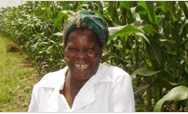In 2003 USAID worked with more than 1,560 small-scale commercial farmers to help improve post-production practices. Most of the farmers work in maize (known as corn in the United States) cultivating about 10,600 acres of land that yield more than 17,500 tons. Agricultural experts and community extension agents set up demonstration sites and provided small grants and one-on-one technical assistance. A third of the farmers received some line of credit and loan repayment rates were 100 percent.
While farmers welcomed increased production and market linkages, the real success lay with farmers like Laston Mugoya. Changing attitudes on the ground and minds in the lending community and commodities market was a difficult task. Even simple efforts, like introducing fertilizers, hit a snag. “I thought at first that the fertilizers would hurt the ground and the plants,” Mugoya said. “Everyone here thought the fertilizers hurt the ground because that is what we are taught for a long time.”
The farmer culture had also previously accepted a certain amount of crop loss to disease and rot. But USAID helped change that mindset through a grant program that provided successful farmers with funds to build cribs for storing and drying. The cribs allow farmers to store maize until the off-season when demand is higher, lending stability to the market by ensuring product availability. Mugoya’s crib holds more than 1,700 pounds of maize; some have a enough capacity to hold 66,000 pounds. |


